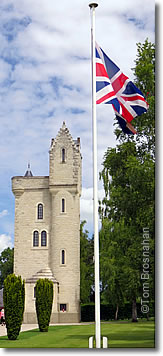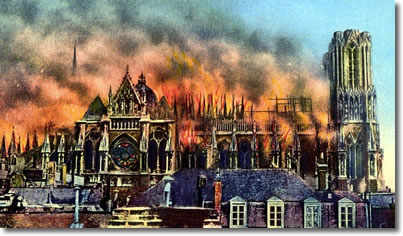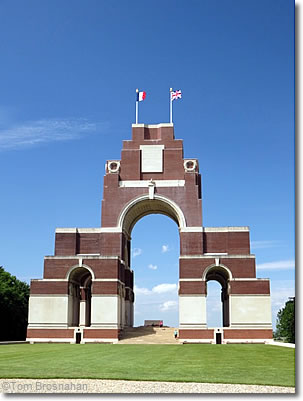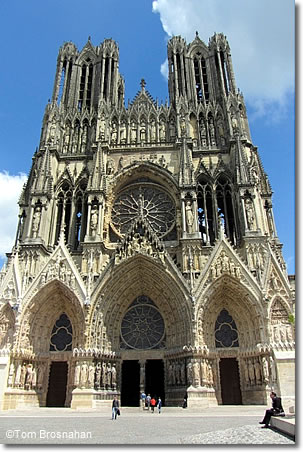|
|
|
The First World War was fought all over the world by the richest, most powerful, most civilized countries, but the Eastern and Western fronts, on both sides of the German and Austro-Hungarian Empires, were the most disputed and destructive. The statistics are staggering: 70 million military personnel engaged, the deaths of 9 million soldiers and 7 million civilians, and 50 million artillery shells fired in one battle alone. (A century later, artillery shells are still being found on former battlefields. It is estimated they will continue to be found for the next 700 years.) Visiting the Battle SitesIt is possible to visit some major battle areas on day-trips from Paris, but it's much more absorbing to tour the cities, towns, battlefields, monuments and cemeteries for several days by car or organized tour. The battle lines of trenches stretched from the Swiss border near Basel in the southeast to the French towns of Metz and Verdun, then west to Reims, Compiègne and Amiens, and north to the Flanders towns of Ypres and Ostend. Historical Summary1914The assassination in Sarajevo on June 28, 1914, of Archduke Franz Ferdinand, heir to the imperial crown of Austria-Hungary, set in motion a chain reaction of preparations for war. Austria-Hungary's declaration of war against Serbia brought Germany and Russia into the war, then France, Belgium and Great Britain. German Imperial armies invaded Luxembourg and Belgium in August 1914, their objective being to outflank the French armies in northeastern France, then to march on Paris. After the initial Battle of the Frontiers in August 1914, the First Battle of the Marne (September 7 to 12) saw the French armies and British Expeditionary Force halt the German advance, setting the stage for the stalemate of trench warfare that persisted until 1917. Horrific losses characterized the First Battle of Ypres (19 October to 22 November), partly because of the use of poison gas, but the battle lines changed little.
1915French armies went on the attack in Champagne and fought the Second and Third Battles of Artois for the Douai plain. British forces fought the Battle of Neuve Chapelle. In the Second Battle of Ypres in April, German forces emitted tons of chlorine gas toward French lines. French and British forces took up the use of poison gas as well. The new German Fokker airplanes were armed with machine guns synchronized to shoot through the propellers—particularly deadly for Allied aviators, whose aircraft did not (yet ) have this technology. 1916Suffering from food shortages caused by the British blockade of its ports, Germany declared unrestricted submarine warfare on Allied and neutral-nation shipping. In the Battle of Verdun, the German attack was initially successful, but later pushed back at huge cost to both sides. British forces were the main force in the Battle of the Somme, but their losses were huge—57,000 in one day alone. The Somme saw total casualties (both sides) of more than a million men. Tanks were used by the British for the first time, but they proved unreliable. French Nieuport fighter planes finally challenged the German Fokkers. 1917German armies staged a strategic retreat to the new, heavily-fortified Hindenburg Line. The USA declared war on Germany after the sinking of the passenger liner Lusitania. American troops began to arrive in France in June, but were not trained and up to strength until late in the year. British and Canadian forces attacked in the Battle of Arras. The French Nivelle Offensive on the Chemin des Dames near Saint-Quentin was a bloody disappointment. Mutiny, indiscipline and desertion became problems among exhausted French troops. British armies began the Flanders Offensive by tunneling under German lines and setting off huge explosives. Germany developed mustard gas, far deadlier than chlorine gas. ANZAC and Canadian forces won ground in the Battle of Passchendaele, but at very heavy cost in killed and wounded. The first massed tank attack led to Allied succes in the Battle of Cambrai. 1918Successful German offensives in the spring allowed the Germans to shell Paris, but American troops were arriving en masse, and Allied counter-offensives at the Second Battle of the Marne and the Battle of Amiens, including French, British, Australian, Canadian, Italian and American troops, hundreds of tanks and aircraft, pushed the German forces back. The American Expeditionary Force achieved its first victory at the Battle of Cantigny in May, assisted French forces in the Aisne Offensive at Château-Thierry and Belleau Wood in June, and fought its major battles in September and October: the Meuse-Argonne Offensives and the Battle of Saint-Mihiel. The Allied Hundred Days Offensive, begun in August, convinced an exhausted Germany that victory was impossible. A revolution in November led quickly to the new German government's agreeing to an armistice. At 11 am on November 11, 1918—the 11th hour of the 11th day of the 11th month—the armistice bringing an end to the fighting on the Western Front was signed at Le Francport near Compiègne. The AftermathCities, towns, villages and fields in northern and northeastern France bore the brunt of the fighting, and the region shows the effects of the war still today. Along with the many battlegrounds, military cemeteries and memorials to the fallen, the cities and towns of the region reflect the conflict through their architecture. The terrible destruction wrought by the ferocious artillery bombardments of five years resulted in whole neighborhoods, and indeed entire towns, being leveled. Historical buildings such as churches and châteaus would be rebuilt as they were before, but many other buildings and neighborhoods were rebuilt in the current architectural style: Art Deco. If you like the style, northern France is one of the best places to see it.
|
|
Thiepval British Monument &
Newfoundland Stag, Beaumont-Hamel Newfoundland Memorial.
|








